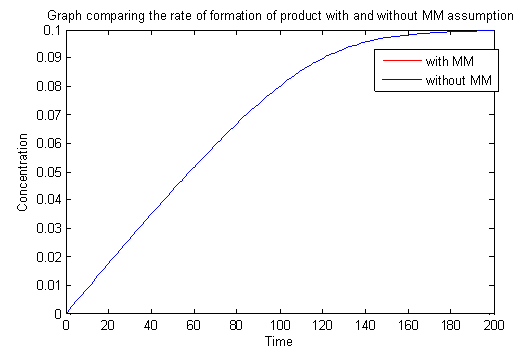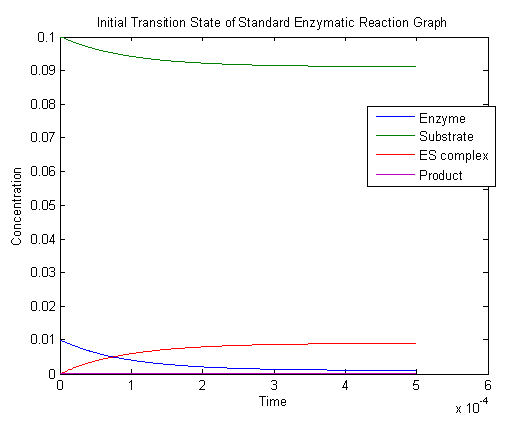Team:Imperial College London/Drylab/Enzyme/Simulations
From 2009.igem.org

Simulation 1: The Generic Graph
This simulation shows the standard enzyme kinetics graph. Concentrations of product, enzyme, substrate, and enzyme-substrate complex over time are shown. Comparisons between the standard enzyme kinetic graph with and without Michaelis-Menten kinetics are made.
In this simulation, all parameters are arbitrary. K1 = 100000, K2 = 1000 and K3 = 0.1. This makes KM = 0.01. Furthermore, [E0] = 0.01 and [S0] = 0.1. The values of K1, K2 and K3 are proportional to their kinetic values [1], while the values of E0 and S0 are chosen to ensure a clear graph.
The above simulation shows that the Enzyme-Substrate complex is at a steady state.
There is a decrease in substrate concentration, accompanied by a rise in product concentration. As all the substrate is used up, there will be no more products formed. There is, however, a time delay before significant product formation starts. This time delay occurs as the enzymatic conversion of substrate to product takes some time.
After this time delay, the concentration of ES complex will gradually drop to 0, while the concentration of enzyme will correspondingly return to initial values.
 In our case where the enzyme concentration is much smaller than the KM value, there is not much difference in the rate of formation of product when we compare the graphs obtained with the Michaelis-Menten assumption, and the graphs obtained when not making this assumption. This shows that our assumptions of Michaelis-Menten kinetics is valid.
In our case where the enzyme concentration is much smaller than the KM value, there is not much difference in the rate of formation of product when we compare the graphs obtained with the Michaelis-Menten assumption, and the graphs obtained when not making this assumption. This shows that our assumptions of Michaelis-Menten kinetics is valid.

Keeping the parameters the same as above, we perform a simulation of the first few moments of the enzymatic reaction. We can observe the transition state of the standard reaction that we would have missed otherwise. Here, the enzyme concentration will decrease to zero due to the formation of enzyme-substrate complex, and there is a corresponding decrease in substrate concentration by an equal amount. There is no rise in product concentration within this short initial period, as the enzymatic conversion of substrate to product takes some time.
Simulation 2: Varying [S0]
Here, the values of K1, K2 and K3 are unchanged. [E0] = 0.01, while [S0] varies from 0.01 (low in relation to KM and [E0]) to 10 (high in relation to KM and [E0]).
In this simulation, we have increasing [S0], while keeping [E0] constant. The slope of the graph of product vs time gives us rate of production of product. For lower values of [S0], the rate of production of the product is directly proportional to the amount of [S0]. However, for higher values of [S0], rate of production of product saturates at a maximum rate. Increasing [S0] will no longer have any effects.
When [S0] is very large, we will get a straight line on the graph of [ES] vs time or ![]() . This is when the rate of formation of product purely depends on [E0] , and that [E0] is the limiting factor. In this case, we can say that the Michaelis-Menten assumption holds, and therefore,
. This is when the rate of formation of product purely depends on [E0] , and that [E0] is the limiting factor. In this case, we can say that the Michaelis-Menten assumption holds, and therefore, 
We can see from the simulations of the rate of formation of product with and without the Michaelis-Menten assumption, that only for values at which the initial enzyme concentration is very large do we get some difference in the rate.
Simulation 3: Varying [E0]
Here, the values of K1, K2 and K3 are unchanged. [S0] = 0.1, while [E0] varies from 0.01 (low in relation to Km and [S0]) to 10 (high in relation to KM and [S0]).
When we increase [E0], we would see an increase in the rates of production of enzyme-substrate complex and product, as well as an increase in rate of the break down of substrate. This is because for a greater initial concentration of enzyme [E], the substrate utilisation rate increases. The initial rate of product synthesis also increases. Therefore, the enzyme has an activity that varies with its concentration.
Moreover, at high values of [E0], we note that the rate of formation of product saturates. This is when [S] becomes the limiting factor. In this case, [ES] decreases rapidly as the substrate is being utilised. Therefore, the enzyme-substrate concentration [ES] no longer has a dynamic steady state. The Michaelis-Menten assumption now no longer holds true.
To conclude, we can say that the Michaelis-Menten approximation only holds for very small values of [E0]. This is because only for these values of [E0], we will obtain approximately ![]() .
.
 "
"






